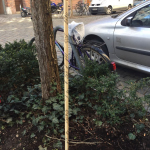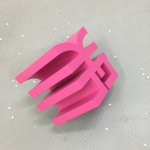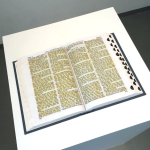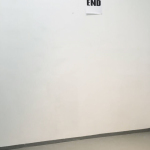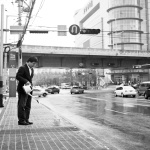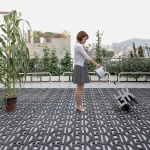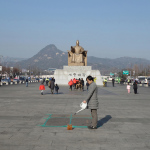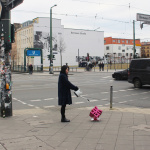In/Sub Text
with
Jun Seok JANG
Diego Leclery
curated by
Sung Rim HWANG
23.03. - 16.04.2017
From left to right
1 Installation view In/Sub Text
2 Diego Leclery, Action Expresses Priorities, 2014, ink on broomstick / d: 2.5 cm x h: 120 cm
3 J unseok Jang, Fantasiless, 2017, polyethylene on artificial turf, 80x80x72 cm
4 Diego Leclery, Highlighted Bible, 2012, highlighter on King James Bible / dimensions variable
5 Diego Leclery, Cheap Kay Rosen Rip-off, 2012, laser print on paper / dimensions variable
6-10 Junseok Jang, all digital print on paper, 40x50 cm
Fantasiless Performance in Sanin-dong, Daegu, 2008
Fantasiless Performance in Ihwa-dong, Seoul, 2014
Fantasiless Performance in Gwanghwamun Square, Seoul, 2017
Fantasiless Performance in Bernauerstr. Berlin, 2017
In/Sub Text
How much of our thoughts and feelings are communicated through language? Although the literal meanings of words and sentences help our communication, most people would admit that we actually understand or feel what’s really hidden behind, between, or beyond the words.
This exhibition shows the works of two contemporary artists who are conveying meaning by dealing with texts.
The Korean artist Junseok Jang, explores various cultural concepts related to the meaning of flowers through the Korean letter '꽃' which means 'flower'. Despite the fact that '꽃' is a phonetic character, he turned '꽃' upside down to make it look like a blooming flower. He uses artificial materials and civilized texts in order to transcend the perception of flowers symbolizing life and beauty. Moreover, these paradoxical methods, while asking us to question the stereotyped concepts of flowers, provide us with culturally expanded meanings such as death, mourning, meditation, healing etc.
Diego Leclery, who works in New York, often collapses our perceptions, of words by simple, witty juxtaposition and a gimmicky play of words and objects: celebrity quotes with old broom sticks; a casual secular gesture with a sacred Bible; ambiguous appropriation hovering between respect and disrespect; and so on. These contradictions give the artwork the magical ability to not merely deconstruct our perceptions but also reconstruct them complexly.
Both of them twist the significations of texts or intervene in the process of conceptualizing and imaging words in our minds, revealing the crack between the text and the concept, or between the text and the image, thereby transforming or expanding their meanings. This is only one of the manifold approaches that reflect their in-depth insights into the signs and symbols of society and culture. Thus, these pieces let us encounter the world afresh by reminding us what we overlook every day like social obsessions, homages, the vanished etc.
__
In / Sub Text
Wie viel von unseren Gedanken und Gefühlen wird durch Sprache kommuniziert? Obwohl die wörtliche Bedeutung von Worten und Sätzen unserer Kommunikation helfen, würden die meisten Leute zugeben, dass wir tatsächlich verstehen oder fühlen, was wirklich hinter, zwischen oder jenseits der Worte verborgen ist. Diese Ausstellung zeigt die Werke zweier zeitgenössischer Künstler, die durch den Umgang mit Texten Sinn vermitteln.
Der koreanische Künstler Junseok Jang erforscht verschiedene kulturelle Konzepte im Zusammenhang mit der Bedeutung von Blumen durch den koreanischen Buchstaben „꽃“, der „Blume“ bedeutet. Trotz der Tatsache, dass „꽃“ ein phonetisches Schriftzeichen ist, hat der Künstler es auf den Kopf gestellt, um es wie eine blühende Blume aussehen zu lassen. Er benutzt künstliche Materialien und kultivierte Texte, um über die bloße Wahrnehmung von Blumen als ein Symbol für das Leben und die Schönheit hinauszugehen. Während wir das stereotypische Konzept von Blumen in Frage stellen, bieten uns diese paradoxen Methoden kulturell erweiterte Bedeutungen, wie den Tod, die Trauer, die Meditation und Heilung.
Diego Leclery, der in New York arbeitet, bringt oft unsere Wahrnehmungen ins Wanken. Angefangen bei Worten durch einfache, witzige Gegenüberstellung und ein effekthascherisches Spiel mit Wörtern und Objekten: Zitate von berühmten Persönlichkeiten mit alten Besenstöcken; eine lässige profane Geste mit einer heiligen Bibel; zweideutige Aneignung schwebt zwischen Respekt und Respektlosigkeit; und so weiter. Diese Widersprüche verleihen dem Kunstwerk die magische Fähigkeit unsere Wahrnehmungen nicht nur zu dekonstruieren, sondern auch komplex zu rekonstruieren.
Beide verdrehen die Bedeutungen von Texten oder greifen in den Prozess der Konzeption und Bildgebung von Wörtern in unseren Köpfen ein und zeigen die Spaltung zwischen dem Text und dem Konzept, oder zwischen dem Text und dem Bild und verändern damit ihre Bedeutungen. Dies ist nur einer der vielfältigen Ansätze, die ihre tiefgreifenden Einblicke in die Zeichen und Symbole der Gesellschaft und Kultur reflektieren. So lassen uns diese Arbeiten der Welt neu begegnen, indem sie uns daran erinnern, was wir jeden Tag übersehen, wie gesellschaftliche Zwangsvorstellungen, Huldigungen, das Verschwundene usw.

